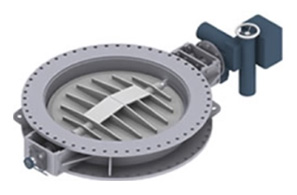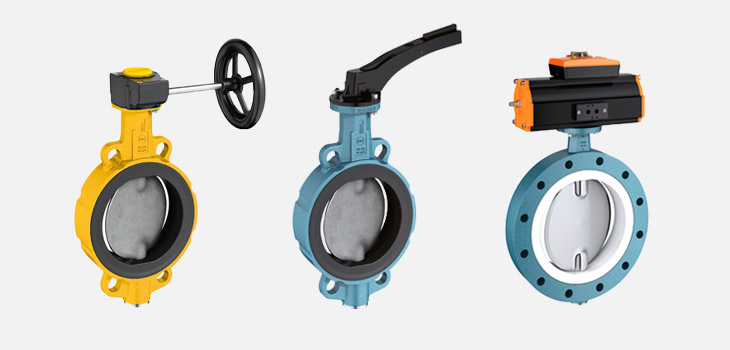A basic introduction to Butterfly Valves
Butterfly Valves get their name from the Butterfly appearance of the disc and stem. The design consists of a round disc that is attached to a shaft rotating 90°. When the disc rotates to be parallel with the flow, the valve is fully open. To close the valve, the disc rotates perpendicular to the flow and isolates the media.

Butterfly valves can act as isolation and control valves. Butterfly valves can control systems when the valve is partially open.
History of Butterfly Valves
For centuries, Butterfly Valves have been used as flow control devices. Historically, they were used as dampers or flow control devices. This was because of the inability to effectively isolate the flow.
In the 1950’s, material improvements took off. The development of synthetics allowed valve manufacturers to incorporate elastomers into pressure handling components like seats and seals. As the advancement of materials continues to this day, so does the advancement of the range of applications that Butterfly Valves can effectively be utilized in.
Anatomy of Butterfly Valves
At a high level, Butterfly Valves can be broken down into four distinct parts, most of which are common in other designs. These are body, disc, seat and shaft.
Body is the pressure retaining component that holds all the components together and connects to the piping system.
Disc is the control element that sits inside of the system, whether open or closed.
Seat works together with the disc to create a seal.
Shaft is attached to the disc and rotates 90 degrees to open or close the valve.
End Connections are covered by API 609, which establishes three types of end connections. These three are the most common for Butterfly Valves. There is the wafer, lugged, and double- flanged connection.

Types of Butterfly Valves
Butterfly valves fall into the category of quarter-turn valves because of their 90° rotation. Looking at Butterfly Valves, there are four general types that vary on application and performance.
Damper Butterfly Valves – are found in low pressure gas applications, such as in ducting systems. Butterfly Damper Valves are lightweight and inexpensive when compared to other damper designs. Sensors are a common pairing with this design, that can see high temperatures in off-gassing applications. Common materials for this design range from steel to plastic.

Resilient Seated Butterfly Valves – are used for general-purpose for applications such as air, water, and light duty solids. The critical component to this style is the resilient seat, which protects the body and shaft from media and ensures isolation.

High Performance (Single or double offset) – Offset refers to the alignment of the valve, which gives the valve a camming action. Depending on the design, there can be an offset on the shaft, seat, or disc. This camming action reduces the degrees of rubbing between the valve, which ultimately increases the cycle life of the valve. Offset designs further expand the range of temperature and pressure limits of the Butterfly Valve.
Torque seated (Triple Offset) – The Triple Offset is the latest innovation in Butterfly Valve design. The three offsets improved upon the other designs, by creating more consistent isolation while reducing rubbing. The Triple Offset design allows the disk to come within a fraction of rotation degree to contact the seat, removing the rubbing while isolating.
Advantages and Disadvantages of Butterfly Valves
| Advantages | Disadvantages |
| Light Weight | Disc is directly in line with the media |
| Quick Operating requires less time to open and close | Seat exposed to media when valve is open |
| No cavities for media to get trapped | Non-piggable |
| Easy to actuate (1/4 turn) and relatively low torque | Disc movement is affected by turbulence |
| Compact design requires less space | Maximum 5% solid handling in slurry applications |
Advantages to the Butterfly Valve revolve around the compact design and ease of operation. The slim valves are often smaller and more lightweight than competing designs. Actuation is easier because of the design’s low torque demand, and the quarter turn actuation requires less time to open and close than competing valves. The other benefit to the design is that there are no cavities that allow media to get trapped.
While the Butterfly Valve has plenty of advantages, they come at some cost. The disc is directly in line with the media, which can become a problem in several applications. One application could be dealing with an abrasive substance (note that Butterfly Valves are only able to handle slurries with 5% solids) that would wear down the disc while in the open position. Another application could be in a circumstance where obstruction of the flow of media is detrimental.
